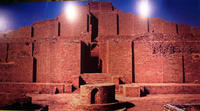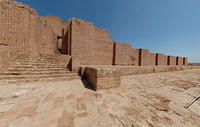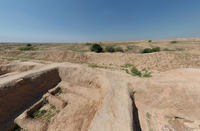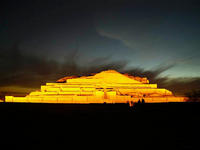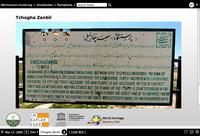You are in: Middle East -> Iran -> Tchogha Zanbil, and traditional search or Image Gallery will yield results of this site only
Tchogha Zanbil
| Site number: | 113 |
|
| Type of site: | Cultural | |
| Date: | 1250 B.C. | |
| Date of Inscription: | 1979 | |
| Location: | Middle East, Iran (Islamic Republic of), Khuzestan | |
Up to 75 images are shown here. Click on each for more details or on Image Gallery for more images.
| Description: | The ruins of the holy city of the Kingdom of Elam, enclosed within three massive concentric walls, are located at Tchogha Zanbil. the after it was invaded by Ashurbanipal, the city (founded in c. 1250 B.C.) remained unfinished, which is echoed in the thousands of unused bricks left at the site. --WHMNet paraphrase from the description at WHC Site, where additional information is available. For 360 degree imaging of this site, click here. | |
| Chogha Zanbil (Persian: چُغازَنبیل) is an ancient Elamite complex in the Khuzestan province of Iran. It is one of the few extant ziggurats outside of Mesopotamia. It lies approximately 25 kilometeres west Dezfoul, 45 kilometres south of Susa and 230 kilometres north of Abadan by way of Ahvaz, which is 120 kilometres away. It was built about 1250 BCE by the king Untash-Napirisha, mainly to honour the great god Inshushinak. Its original name was Dur Untash, which means 'town of Untash', but it is unlikely that many people, besides priests and servants, ever lived there. The complex is protected by three concentric walls which define the main areas of the 'town'. The inner area is wholly taken up with a great ziggurat dedicated to the main god, which was built over an earlier square temple with storage rooms also built by Untash-Napirisha. The middle area holds eleven temples for lesser gods. It is believed that twenty-two temples were originally planned, but the king died before they could be finished, and his successors discontinued the building work. In the outer area are royal palaces, a funerary palace containing five subterranean royal tombs. Although construction in the city abruptly ended after Untash-Napirisha's death, the site was not abandoned, but continued to be occupied until it was destroyed by the Assyrian king Ashurbanipal in 640 BCE. Some scholars speculate, based on the large number of temples and sanctuaries at Chogha Zanbil, that Untash-Napirisha attempted to create a new religious center (possibly intended to replace Susa) which would unite the gods of both highland and lowland Elam at one site. --Wikipedia. Text is available under the Creative Commons Attribution-ShareAlike License. For 360 degree imaging of this site, click here. | ||
| Source: | http://whc.unesco.org/en/list/113 | |
| Reference: | 1. UNESCO World Heritage Center, Site Page. | |


